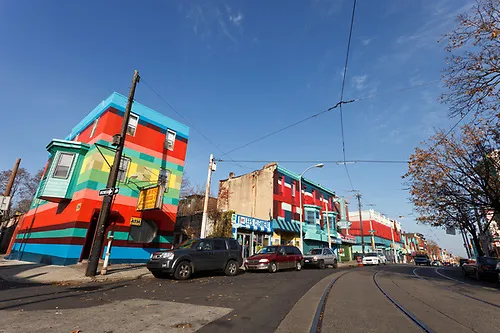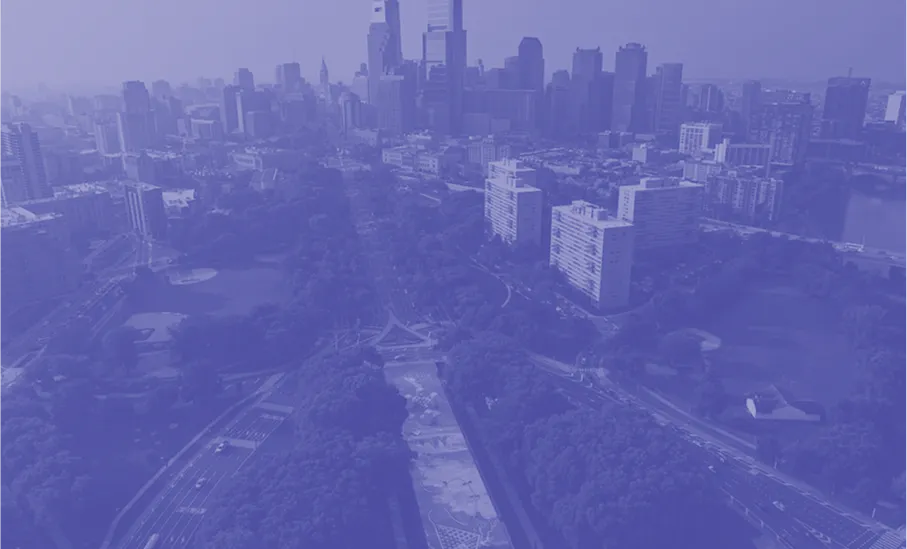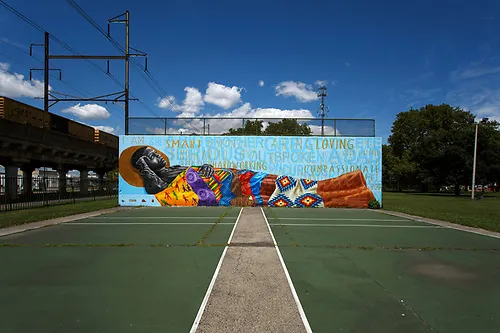Philly Painting

That spirit of transformation is at the heart of both the artists’ work and of Mural Arts collaboration with a range of funding and civic partners to revitalize and re-energize one of Philadelphia’s oldest commercial corridors, a section of Germantown Avenue in North Philadelphia at the intersection of Lehigh Avenue. A larger economic development strategy, spearheaded by Darrell Clarke, has also engaged the city’s Department of Commerce and the Planning Commission. Essential to the project’s success is the collaboration of local partners: the Village of Arts and Humanities that is hosting the artists’ residency; Diane Bridges of NET CDC; and others to build trust within the community. The team of partners and individuals also includes: Interface Studio and dozens of local business and community representatives.
Over the course of their residency, Haas & Hahn were challenged to consider design not just for a block but for an entire commercial corridor. Philadelphia’s Commerce Department, a major partner in this effort, recognizes the potential of a major project like this to radiate optimism and serve as catalyst for additional positive change and commercial potential.
Based out of their temporary digs just off of Germantown Avenue in North Philadelphia, the artists captured important images of the neighborhood, both figurative and literal, and ultimately developed a color palette based on patterns of recurring primary and secondary hues that reflect the neighborhood and the city’s quintessentially rich and complex character. In developing the designs for the work in Germantown, they reshaped and scaled these swatches of “native” color to transcend the architecture of the individual buildings, and lend uniformity to a lively but visually incoherent stretch of the avenue.
Ultimately, Haas & Hahn want to bring people into the community — customers to the local business, more businesses to the street and more people employed through both the efforts and results of the transformation. They want to help make the neighborhood the vibrant place it once was. They see the project as an urban experiment, to see what happens to the post-modern American city and to see how we value and define our neighborhoods, essentially using the project “to market the community.” The artists have also developed a project logo that they plan to have copyrighted to the zip code, so that local merchants can take advantage of the increased attendance in the area.
In addition to the painting process, which will engage seven local apprentices, five full time crew members (with the hope the team will grow), and five Guild participants, other community members are actively participating in production and marketing. Local merchants and the Director of NET CDC will serves as spokespersons. Germantown Avenue merchants have printed the painting team’s uniform and merchandise.
As exciting as the project is, Philly Painting the Avenue (the working title of the Germantown Avenue project) is not without its challenges: architectural, human and logistical. The commercial corridor between Huntingdon and Somerset is characterized by small businesses and not-for-profits, vacant buildings, wildly varied signage scale, styles and surfaces, deteriorating facades and cornices with boarded up windows. The building owners and merchants have a predictably wide range of color and design preferences that are rooted in what they sell, where they come from, and how they perceive the larger design concept. And finally, Germantown Avenue has a variety of power and utility lines, SEPTA’s venerable “route 23” and the relics related to the trolley tracks associated with it, and parking on both sides of the street. As complex as the challenges are, however, the potential is palpable. As the artists and project staff have returned weekly to canvas merchants and seek their approval, the enthusiasm for the potential of this project to create enthusiasm and cohesion through art has grown with more and more merchants wanting to participate.

